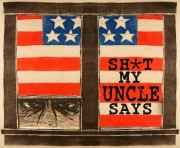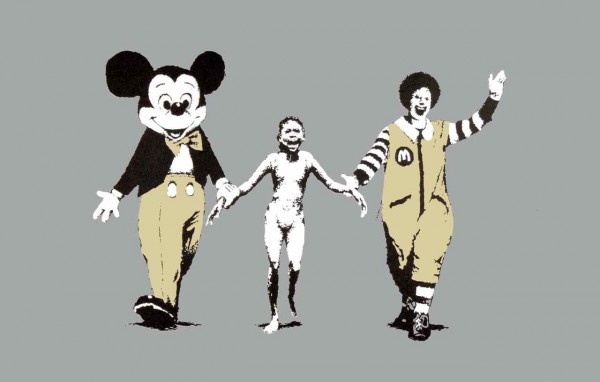BY WILLIAM C. HENRY Sale! Sale! Boys’ and girls’ fashion jeans – cheap! Grab ’em at Children’s Place! Ladies’ pants suits – cheap! Buy two and save even more at your nearest Cato! Outfit the entire family for less! You always get more for your money at Walmart! Always! Gee, from all outward appearances you’d think that today’s garment business was the perfect win-win situation for all  concerned. Consumers enjoying low prices — brand names and retailers enjoying high profits. Free enterprise functioning at its best, no? Well, yeah, except for the folks who actually make the clothes that is. Did you know that since 2005 “fashion” in this country and elsewhere has cost more than 1000 Bangladeshis the ultimate price, their lives. They have been, and continue to be, the collateral damage in the world’s wardrobe wars, and NO ONE, not manufacturers, not brand names or retailers — and certainly not consumers — has shown they give even the slightest damn about it so long as profits and savings continue to be in style.
concerned. Consumers enjoying low prices — brand names and retailers enjoying high profits. Free enterprise functioning at its best, no? Well, yeah, except for the folks who actually make the clothes that is. Did you know that since 2005 “fashion” in this country and elsewhere has cost more than 1000 Bangladeshis the ultimate price, their lives. They have been, and continue to be, the collateral damage in the world’s wardrobe wars, and NO ONE, not manufacturers, not brand names or retailers — and certainly not consumers — has shown they give even the slightest damn about it so long as profits and savings continue to be in style.
Last November over 100 Bangladeshis were burned and trampled to death in a clothing factory fire in Tazreen, Bangladesh. Turns out that was but a preview of the carnage to come. As most of you who still read or watch the news already know, at least 600 Bangladeshis have perished in the latest preventable tragedy to beset the garment workers of Bangladesh. It didn’t have to happen. None of it did. As is often the case in tragedies like this, the cause is rooted in good old fashioned financial greed with a generous portion of the buying public’s “not my responsibility” thrown in. Do Bangladeshi politicians, inspectors (18 for 4,500 factories), building owners and their clothing manufacturer tenants bear blame? Of course. But only some of it. Bangladesh is an incredibly poor country. The average Bangladeshi garment worker earns about $37.00 a month for backbreaking 12 to 14 daily hour shifts in typically oppressive sweat shop confines. Surprisingly, many of the manufacturers barely make a profit. The real money ends up in the hands of the retailers (50%) and the brand names (25%). The manufacturers’ portion, if they’re lucky, amounts to around 10%, and the workers themselves end up with roughly 1%. The rest is eaten up by transport and taxes.
So, who bears the bulk of the blame for these completely avoidable slaughters? Let’s place most of it right where it belongs: at the feet of the brand names and retailers, and a buying public who simply couldn’t be bothered with learning about the conditions under which their fashions were being assembled. It was most certainly not an “out of sight, out of mind” experience for the former two. The deplorable working conditions that precipitated this disaster didn’t just come to light. These were no startling first-time revelations. American clothing interests have been turning a blind eye to these kinds of shameful employment practices for over a decade. Good old fashioned corporate avarice long ago dulled any sense of compassion or morality that could have prevented this kind of calamity. Constant insistence that the manufacturers produce an ever greater volume at even lower cost — with the implication that said “extortionists” could always take their business elsewhere — was nothing less than greed-bred callousness looking for a catastrophe to effect.
Sadly, it never had to turn out this way. A pennies-on-the-dollar (compared to their profits) commitment of $500,000 from at least four of the major players involved such as Walmart, The Gap, H&M, J.C. Penney, Abercrombe & Fitch, Kohl’s, Sears or Disney would enable the establishment of a legitimate workplace inspection and safety program encompassing the protections necessary to prevent just such carnage. To date all of the industry’s leaders except Tchibo and PVH Corp. have declined to participate. As for Disney, they’ve “ducked and run” completely. Just what Bangladeshis need right now: less income! And you thought Donald was all about wholesomeness and family values. As Iain Banks so discouragingly put it in Complicity, “The point is, there is no feasible excuse for what we are, for what we have made of ourselves. We have chosen to put profits before people, money before morality, dividends before decency, fanaticism before fairness, and our own trivial comforts before the unspeakable agonies of others.” Regardless of its original aim, those words seem like an altogether fitting commentary on an industry unlikely to change its ways and which professes to be built around making us look our best so that we might all feel better about ourselves.
RELATED: Fresh Air Interview With Elizabeth Cline, Author Of The Shockingly High Cost Of Cheap Fashion
ABOUT THE AUTHOR: Fed up early stage septuagenarian who has actually been most of there and done most of that. Born and raised in the picturesque Pocono Mountains. Quite well educated. Very lucky to have been born into a well-schooled and somewhat prosperous family. Long divorced. One beautiful, brilliant daughter. Two far above average grandsons. Semi-retired (how does anyone manage to do it completely these days?) and fully-tired of bullshit. Uncle of the Editor-In-Chief.

